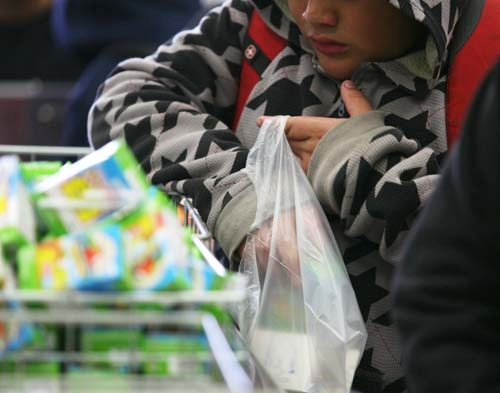School breakfast bill adds up in Clark County




The freezer the size of a football field is packed full of food.
It’s everything needed to daily serve 200,000 meals, most of which are prepared from scratch and trucked to the Clark County School District’s 357 public schools.
Over the course of this school year, the kitchen near Las Vegas Motor Speedway will provide close to 40 million meals to students of the nation’s fifth-largest school district.
District cooks never have been so busy, but not because they are serving more school lunches.
Last school year, Clark County made the second-biggest jump nationwide among large school districts for breakfasts served to low-income students. It increased the number of meals handed out by 46 percent over 2010-11, according to a report by the Food Research and Action Center, a national nonprofit organization working to eradicate hunger in the United States.
But student demand isn’t driving the jump, and much of the food being served is going into the garbage .
All 217 elementary schools already were offering breakfast to students before the bell rang each morning.
Superintendent Dwight Jones created the demand that drove the jump in 2011 by requiring 36 elementary schools with high poverty rates to make breakfast part of the school day – a program called Breakfast after the Bell – and have students go to the cafeteria before class. The program expanded to 76 schools in January 2012.
“The superintendent wants kids fed,” said Charles Anderson, director of district Food Services.
But many students are throwing their breakfasts away.
“It seems like money being wasted,” said Christopher Davis, a third-grade teacher at Craig Elementary School in North Las Vegas.
Still, the district earns millions of dollars whether students eat or not.
The district received $71.9 million in federal reimbursements in 2010-11 for low-income breakfast and lunches. It expects $85.5 million this year.
The U.S. Department of Agriculture reimburses the district for each meal – $1.25 for reduced breakfast and $1.55 for free breakfast – that a low-income child takes, breakfast or lunch. The district even receives an extra 30 cents per student if a school proves “severe need,” meaning at least 40 percent of meals are served to low-income students.
That’s an easy bar to meet for district schools where one out of two students, on average, belong to low-income families. Currently, 312 of the district’s 357 schools are “severe need.”
FOOD THROWN AWAY
Just because a poor student eats school lunch, is school breakfast also a must?
The district fed breakfast to 55,600 low-income students daily in 2011-12, a sharp rise of 17,500 students. More than 61,000 students are taking school breakfasts this year, reports district Food Services.
But at Craig, where 96 percent of the school’s 800 students are low income, only a fifth of the children came early for breakfast when it was served 10 minutes before school, Principal Kelly O’Rourke said.
“I don’t think any more kids are actually eating school breakfast now,” even though many of the school’s children are in the program, she said.
The reason: Much of the food now lands in the garbage, unopened.
The school’s physical education teacher even quantified the waste by assigning each class of fifth-graders to tally what they didn’t eat. The three classes reported a total of 700 breakfast items unopened and thrown away by students over three weeks. And that’s just one grade of 125 students.
The most common reason that low-income children don’t eat school breakfast is because they are being fed at home, said Anderson, referencing a University of Nevada, Las Vegas report commissioned by the district. And like a buffet, the federal program doesn’t allow food to be saved or taken home, even though Food Services individually packages everything from apple slices to cinnamon rolls.
Anderson and staff asserted that money is not the driving factor for the district or Superintendent Jones in making breakfast part of school.
“There’s no doubt we all want the kids to eat,” said Virginia Beck, assistant director of procurement and production at Food Services, adding that she has heard anecdotally “the kids are paying attention better now than before.”
However, the district hasn’t tracked students at these 76 schools to see if mandatory breakfast has translated to better grades, she said.
CONSUMING CLASS TIME
Several teachers at Craig, near Gowan Road and Civic Center Drive, said they support the intention of Breakfast after the Bell, but they’re losing about 30 minutes of instructional time each day, which sounds small but amounts to 90 hours over the school year.
“The kids were eating breakfast already,” Craig teachers Hali Davis and Lindsey Pratus said.
Wasted time is arguable, Principal O’Rourke said, but teachers can work around it by having students read during that time or do other, less hands-on work.
“My biggest concern is the waste of food,” Beck said.
“That occurs,” Anderson said of the waste, noting that just about every school’s staff expresses concern about thrown-away food. “But there’s no way around it.”
For the district to be reimbursed, the low-income students must take all food and drink items or none, even if they already ate breakfast and just want a juice box.
And the district wants to be reimbursed. It assigns a worker to every cafeteria to make sure every child in the breakfast line takes every item. Students who just take a milk or juice box are told to go back and get the rest. And the school can’t take back unopened items.
“It’s called a full-meal reimbursement,” said Anderson, blaming the federal system.
But the district has instituted all of the changes recommended by the Food Research and Action Center to capture federal reimbursements that would otherwise be lost because poor children aren’t taking school breakfasts.
As recommended by the center, Jones made breakfast part of the school day and universally free to all students at poor schools.
“Programs that offer meals at no charge to all students, regardless of income, help reach more children,” the center noted in its message to districts. It also suggested “grab and go” carts, which the district now offers.
BREAKFAST AS BIG BUSINESS
Despite the growing number of morning meals being served, Clark County is one of the nation’s top five districts in terms of lost meal-reimbursement dollars, according to the center.
Less than half of the district’s 131,000 low-income students who eat lunch also eat school breakfast, meaning the district is losing out on millions of dollars.
If 33,000 more students take breakfast, Clark County would receive $8.7 million more, the center said.
School meals have become a $3 billion industry of federal reimbursements in this country, more than doubling since the $1.39 billion reimbursed in 2000.
That may have something to do with a record rate of students taking school breakfasts. For the first time, half of all low-income American students eating school lunch also took school breakfast in 2011-12.
How much they actually consume is another thing.
As Principal O’Rourke walked by a cafeteria garbage can crammed with unopened milk cartons, fruit cups and cinnamon rolls, she said, “I see piles and piles of food getting thrown away.”
Contact reporter Trevon Milliard at
tmilliard@reviewjournal.com or 702-383-0279.












